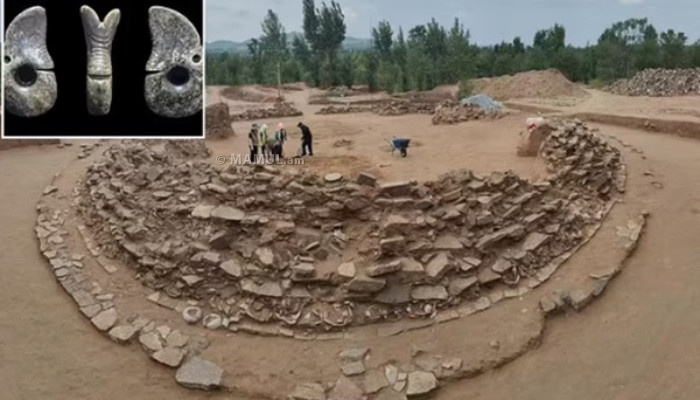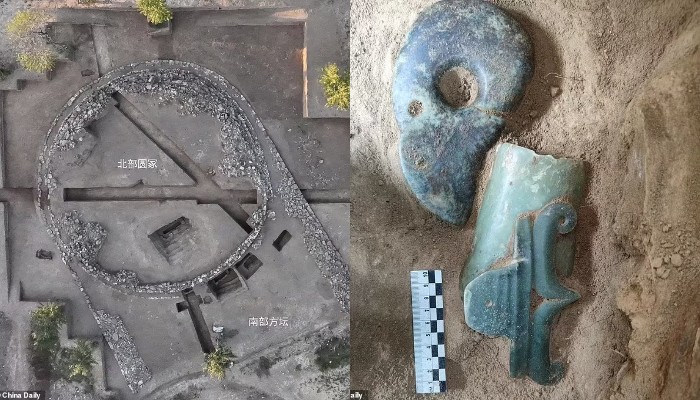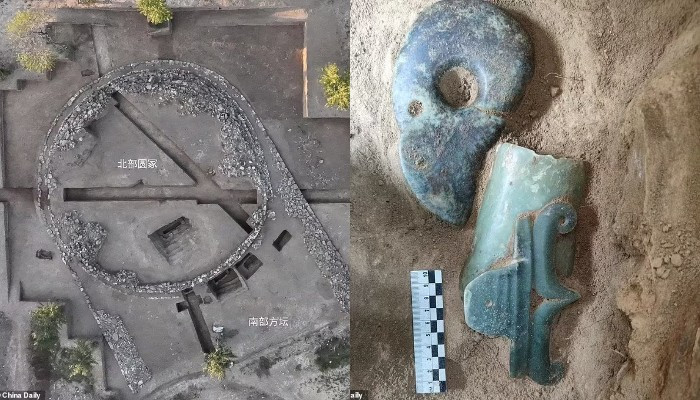Archeologists make 5,000-year-old discovery while excavating an ancient burial site
 2451 Monday, 14 October, 2024, 19:24 A 5,000-year-old discovery made at an ancient burial site in Northern China could finally reveal how Chinese civilizations formed. Archaeologists unearthed more than 100 jade relics in the city of Chifeng, including three dragons - with the largest of which was about half a foot long. The elaborate burial site was comprised of a circular tomb and a sacrificial alter, revealing the prehistoric culture of the Hongshan that lived in the region around 3000BC. The relics were similar to ancient artifacts previously found in other provinces and suggested the Hongshan's culture pulled inspiration from three other societies that live at least 100 miles away. The team determined that the Hongshan civilization may have exchanged artistic ideas with the Yangshao and Liangzhu cultures. Researchers at the Chinese Academy of Social Sciences' Institute of Archaeology recovered the jade relics at the Yuanbaoshan burial site, along with ruins, pottery and human remains. Three dragons were among the relics excavated from beneath the walls of the circular tomb that measured about 77 feet in diameter. The jade dragons had a more chubby and pig-headed appearance than those made today. In China, jade dragons have long been a symbol of good luck, protection of evil spirits and was believed to connect both the physical and spiritual realms after death. The team was shocked to find the six-inch jade dragon that was slightly longer than the one unearthed 93 miles away in the Liaoning province. They also identified several stone structures and semi-underground houses at the burial site, which were likely tombs for high-ranking individuals. And the altars were used to conduct religious ceremonies. The Hongshan culture historically practiced a variety of religious ceremonies, including burying their dead on ceremonial platforms alongside carved jade and had a unique sacrificial system that involved using dragon artifacts to worship their ancestors. Jia Xiaobing, a researcher at the Chinese Institute of Archaeology, confirmed that the tomb's layout is similar to those found in Niuheliang - a village about 85 miles away. It was identified by its southern circle, northern alter and northern tomb layout and the jade artifacts also revealed a cross-over in stylistic similarities used in other cultures, representing a connection for the first time. Dang Yu, research librarian at the Inner Mongolia Institute of Cultural Relics and Archaeology said the jade relics also included ceremonial tools and ornaments, axes and headgear. One piece of headgear resembled those belonging to the Lingjiatan culture from 5,300 to 5,800 years ago in the present-day Anhui province that further proved the two cultures had cultivated long-distance cultural trade. 'Such consistency in an expanded area proves that a shared belief system existed among the Hongshan ancestors,' Xiaobing told China Daily. Hongshan culture sites dating back to between 4700 BC and 2900 BC have been found stretching from Inner Mongolia to Liaoning in the northern region of the country. The researchers are conducting additional tests and studies to learn more about the relics and when the burial site was constructed.   |

Oxford University Press names "rage bait" as word of the year 2025
374Yesterday, 23:35
US and Syrian forces conduct strikes on ISIS weapons storage facilities in Rif Damashq province
532Yesterday, 19:41
Pope Leo takes peace message to Lebanon, target of Israeli strikes
70930.11.2025, 20:31
Rubio and Witkoff are meeting with Ukraine’s negotiators as Trump pushes to broker an end to the war
61930.11.2025, 18:36
Power outages reported in some districts of Kyiv (video)
98229.11.2025, 12:31
Suspect in D.C. National Guard shooting identified as 29-year-old Afghan national
109427.11.2025, 10:17
Guinea-Bissau officers take ‘total control’ and close borders amid election chaos
109626.11.2025, 21:27
IAEA: In the event of peace in Ukraine, Zaporizhzhia Nuclear Plant needs a cooperation agreement
124126.11.2025, 00:06
